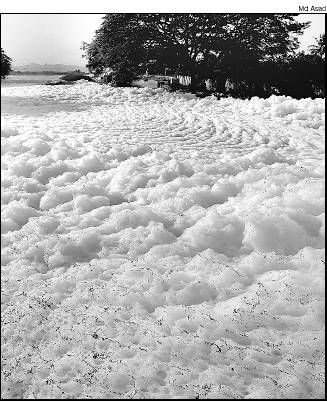Bellandur Lake froths in death

Bellandur ‘iceberg’ at melting point!
Times of India
Bellandur: Iceberg once more! The massive 950-acre Bellandur lake has reared its frothy head again. This, after the brouhaha over restoration plans for the city’s biggest and worst polluted water body just four years ago.
When the Bellandur ‘iceberg’ was spotted in 2000, the Karnataka State Pollution Control Board (KSPCB) was quick to slap notices on 10 garment manufacturing units around the lake, warning them against direct discharge of effluents into the lake. Some units shut shop and the rest set up effluent treatment plants, which the KSPCB says, are “working well’’. But the froth continues.
In 2000 when The Times of India got the frothy samples tested by KSPCB, it was found that the detergent-based effluents discharged by erring industries contained surfactants over seven times higher than permissible limits.
KSPCB member secretary (in-charge) Rashmi V. says it is difficult to point out a single reason for the frothy appearance, given the magnitude of activities around the lake. There is no underground drainage in the seven villages around. Shops, hotels and other smaller establishments are found directly discharging effluents into the lake. The IISc notes that the effluents give a frothy appearance due to turbulent waters during rains.
The secondary treatment plant (STP) set up by the BWSSB at Koramangala-Chalaghatta valley is inadequate as it still needs to expand its treatment capacity by another 40 per cent to treat the wastes here. Sources said there is no sufficient power backing even for the existing STP. BWSSB officials, however, say an action plan should be ready by June 2005.
The Lake Development Authority (LDA) received the nod from the ministry of environment and forests to restore the 300-year-old lake using bio-remedial techniques. Though the approval came through in March 2003, the restoration began in January.
The estimated Rs 5.5-crore project, expected to be readied in three years, boasts of a technique that is said to ensure minimum disturbance to the existing ecology at Bellandur. “Microbiological agents, capable of breaking organic and inorganic sediments, will be introduced into the lake followed by aeration and oxygenation,’’officials explained.












0 Comments:
Post a Comment
<< Home